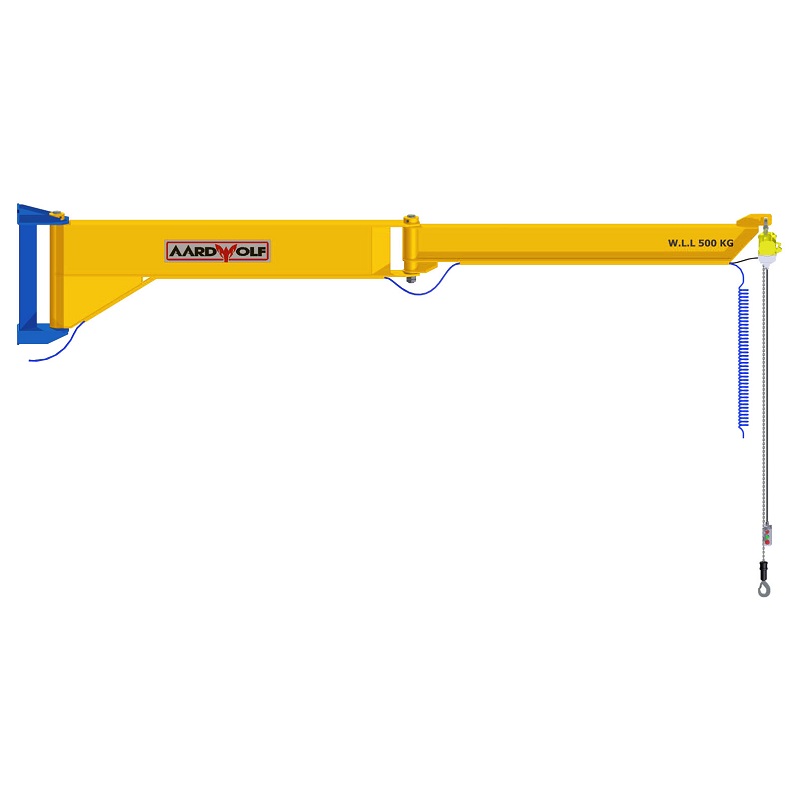Installing a jib crane correctly is critical for ensuring safe, efficient, and long-term lifting operations. Whether it’s a freestanding jib crane, wall-mounted jib crane, or mast-type jib crane, a precise installation process safeguards against mechanical failure, enhances productivity, and ensures regulatory compliance. This guide provides a step-by-step approach to proper jib crane installation, reflecting years of experience, expertise, authoritativeness, and trustworthiness in the material handling equipment industry.
If you’re still deciding between lifting systems, see our full comparison: Jib Crane vs Gantry Crane: Which One Suits Your Job Site Best?
Why Proper Jib Crane Installation Matters
Table of Contents
ToggleImproper installation can compromise crane performance, reduce its lifespan, and lead to serious safety hazards. A professionally installed supports accurate material handling, minimizes operational downtime, and prevents costly breakdowns or injuries.
Each type of jib crane has specific mounting and structural requirements. Understanding the differences is key before beginning installation. To determine the right model for your site, read Jib Crane: Choose the Best Type for Your Workshop.
Overview of Jib Crane Types and Installation Requirements
1. Freestanding
- Mounting: Anchored to a reinforced concrete foundation.
- Load Capacity: Typically 500 kg to 5,000+ kg.
- Rotation: 360°
- Common Use: Open workshops, production floors, warehouses.
2. Wall-Mounted Jib Crane
- Mounting: Fixed to a structural wall or vertical column.
- Load Capacity: Up to 2,000 kg.
- Rotation: 180°–200°
- Common Use: Assembly lines, machine stations, confined spaces.
3. Mast-Type Jib Crane
- Mounting: Between the floor and overhead support.
- Load Capacity: Medium-duty (up to 3,000 kg).
- Rotation: 360°
- Common Use: Where foundation excavation is limited but vertical support exists.
4. Articulating Jib Crane
- Mounting: Floor, wall, or ceiling.
- Load Capacity: 125–1,000 kg.
- Rotation: Dual-arm articulation for complex paths.
- Common Use: Tight or cluttered spaces requiring precision.
To understand how different configurations suit outdoor workspaces, check out The Best Jib Crane Types for Outdoor Material Handling.
Pre-Installation Checklist
Before you begin:
- ✅ Review manufacturer guidelines and technical specifications.
- ✅ Confirm that the installation site meets structural and spatial requirements.
- ✅ Obtain any necessary permits or engineer approvals.
- ✅ Gather safety equipment and certified tools.
Step-by-Step Guide: How to Install a Jib Crane
Step 1: Site Evaluation and Layout Planning
Key Actions:
- Measure available space, clearance height, rotation radius, and floor thickness.
- Ensure there are no obstructions (pipes, conduits, overhead beams).
- For wall-mounted cranes, inspect wall integrity.
- For freestanding cranes, assess soil condition and prepare foundation specs.
Expert Tip: Hire a certified structural engineer to assess the building’s ability to support dynamic load forces—especially for mast mounted jib cranes or wall attachments.
Step 2: Foundation Preparation (Freestanding Only)
Key Actions:
- Excavate the floor based on the foundation layout provided by the manufacturer.
- Install rebar mesh for reinforcement.
- Pour high-grade concrete (minimum 3,000 psi) to specified depth—often 30–50 cm.
- Allow curing for at least 7 days.
Note: This step is critical for freestanding jib cranes as their stability and load-bearing capability depend entirely on foundation strength.
Step 3: Anchor Bolt and Base Plate Installation
Key Actions:
- Position the template with anchor bolts into the wet concrete (freestanding).
- For wall-mounted systems, mark and drill anchor points on the wall.
- Align the crane’s base plate or wall bracket with pre-drilled or embedded anchors.
Tools Required:
- Torque wrench
- Level
- Hammer drill (for wall mounts)
Step 4: Assembling the Mast and Boom
Key Actions:
- Install the vertical mast securely using torque specs from the manufacturer.
- Mount the jib arm (straight or articulating) to the mast or wall bracket.
- Confirm alignment and levelness before tightening hardware.
For Mast-Type Cranes:
- Fix the top bracket to an overhead beam or truss.
- Apply tension evenly between the floor and ceiling anchor points.
Step 5: Hoist and Trolley Installation
Key Actions:
- Install the trolley onto the boom.
- Mount the electric or manual hoist to the trolley.
- Connect power lines and control pendant (for electric hoists).
- Check all mechanical connections for safety and movement.
Safety Check:
- Test limit switches and emergency stop functions.
- Inspect wire ropes or chains for damage or improper routing.
Step 6: Load Testing and Certification
Key Actions:
- Conduct static and dynamic load tests using certified weights.
- Rotate the boom with full load to test swing radius and bearing operation.
- Ensure compliance with OSHA, ANSI, or regional lifting standards.
Documentation:
- Record installation specs, test results, and operator training logs.
- Affix the load capacity label to the crane arm.
Maintenance After Installation
Routine maintenance ensures performance and safety. Key maintenance areas:
- Weekly: Visual inspection, lubricate moving parts.
- Monthly: Inspect fasteners, wiring, limit switches, and trolley wheels.
- Annually: Perform full load testing and professional inspection.
Schedule preventative checks for critical components like the base, mast welds, and hoist brakes.
Common Installation Mistakes to Avoid
- Installing on insufficient concrete or weak wall structures.
- Ignoring rotation clearance or surrounding obstacles.
- Failing to properly torque bolts or level the crane.
- Not conducting a post-installation load test.
Final Thoughts: Installing Your Jib Cranes with Confidence
A properly installed jib crane can transform your lifting operations—boosting safety, efficiency, and operator confidence. Whether you’re working with freestanding, mast-type, or articulating jib cranes, a systematic approach to installation ensures long-term value and compliance with industry standards.
Need help choosing the right model for your application?
Explore for more jib crane products designed for precision, durability, and ease of installation.


















Please log in to leave a comment.